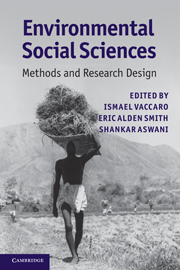Book contents
- Frontmatter
- Contents
- Contributors
- Foreword
- Preface
- 1 Introduction
- 2 People, numbers, and natural resources: demography in environmental research
- 3 Production decisions and time allocation: a guide to data collection
- 4 Analyzing the politics of natural resources: from theories of property rights to institutional analysis and beyond
- 5 Extreme events, tipping points, and vulnerability: methods in the political economy of environment
- 6 Local communities and natural resources: ethnobiology in practice
- 7 Mapping histories: cultural landscapes and walkabout methods
- 8 Metaphors and myths in news reports of an Amazonian “Lost Tribe”: society, environment and literary analysis
- 9 Water decision-makers in a desert city: text analysis and environmental social science
- 10 Linking human and natural systems: social networks, environment, and ecology
- 11 Khat commodity chains in Madagascar: multi-sited ethnography at multiple scales
- 12 Spatiotemporal methodologies in environmental anthropology: geographic information systems, remote sensing, landscape changes, and local knowledge
- 13 Deep time, diachronic change, and the integration of multi-scalar data: archaeological methods for exploring human–environment dynamics
- 14 Comparing trajectories of climate, class, and production: an historical ecology of American yeomen
- 15 Socioecological methods for designing marine conservation programs: a Solomon Islands example
- Index
- References
10 - Linking human and natural systems: social networks, environment, and ecology
Published online by Cambridge University Press: 05 June 2012
- Frontmatter
- Contents
- Contributors
- Foreword
- Preface
- 1 Introduction
- 2 People, numbers, and natural resources: demography in environmental research
- 3 Production decisions and time allocation: a guide to data collection
- 4 Analyzing the politics of natural resources: from theories of property rights to institutional analysis and beyond
- 5 Extreme events, tipping points, and vulnerability: methods in the political economy of environment
- 6 Local communities and natural resources: ethnobiology in practice
- 7 Mapping histories: cultural landscapes and walkabout methods
- 8 Metaphors and myths in news reports of an Amazonian “Lost Tribe”: society, environment and literary analysis
- 9 Water decision-makers in a desert city: text analysis and environmental social science
- 10 Linking human and natural systems: social networks, environment, and ecology
- 11 Khat commodity chains in Madagascar: multi-sited ethnography at multiple scales
- 12 Spatiotemporal methodologies in environmental anthropology: geographic information systems, remote sensing, landscape changes, and local knowledge
- 13 Deep time, diachronic change, and the integration of multi-scalar data: archaeological methods for exploring human–environment dynamics
- 14 Comparing trajectories of climate, class, and production: an historical ecology of American yeomen
- 15 Socioecological methods for designing marine conservation programs: a Solomon Islands example
- Index
- References
Summary
Introduction
This chapter examines the methods employed in research exploring the relationships between systems of human relations, or social networks, and people’s interactions with various elements of natural ecosystems. Social networks are fundamental to understanding cultural systems of resource sharing; cooperation in hunting, fishing, and agricultural production; the diffusion of technological innovations; the sharing and distribution of ecological and environmental knowledge; and in human adaptive responses to changes at various scales from acute ecological disruptions, such as hurricanes, to major environmental shifts, such as global climate change. In addition, human behavioral and ecological networks are interconnected in ways that can foster change through direct and indirect network effects and through system cascades. Thus, factors contributing to changes in ecosystem structure and function at one level (e.g., climate change) can influence the structure of human behavioral systems and, conversely, factors affecting changes in the structure of human behavioral systems (e.g., shifts in fishing effort due to prices or regulation) can ultimately impact elements of ecosystem function (e.g., top-down trophic cascades).
Several interesting social network theoretical principles may be at play in the linking of human and natural systems and in understanding and modeling human environmental and ecological behavior. These include such things as homophily (e.g., “birds of a feather flock together”), preferential attachment (e.g., “the rich get richer”), and various topological motifs or features of both ecological and social networks (e.g., small worlds, clustering, transitivity, cohesion). In addition, social capital, a recent social scientific interest, is usually conceptualized in social network terms (Burt 1992; Lin 2002).
- Type
- Chapter
- Information
- Environmental Social SciencesMethods and Research Design, pp. 212 - 237Publisher: Cambridge University PressPrint publication year: 2010
References
- 5
- Cited by



